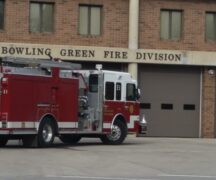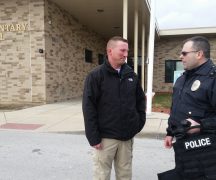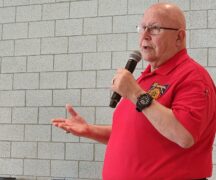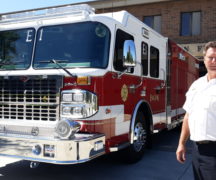By JAN LARSON McLAUGHLIN
BG Independent News
Bowling Green Fire Division is in a radio deadzone – but $500,000 in the state capital budget may provide the fix.
“We identified several years ago that we have a problem,” Bowling Green Fire Chief Bill Moorman said.
There are times when firefighters or paramedics are inside large buildings at Bowling Green State University, manufacturing sites or downtown, that they are unable to have radio contact with those outside the buildings.
“We’re in a deadzone here in Bowling Green,” the chief said. “It’s a dangerous situation.”
The $500,000 would be used to build a MARCS Tower on public property, increasing portable radio coverage used by first responders and public safety providers within Bowling Green and additional surrounding areas.
MARCS – the Multi-Agency Radio Communication System – is Ohio’s wireless, digital communication network for first responders that enables local, state and federal agencies to communicate with each other.
More than 2,300 public safety/public service agencies use MARCS.
The need for a different first responder communication system in Ohio came to attention during the 1990 Shadyside flood and the 1993 Lucasville Prison riot. Gaping holes in communication with the existing radio systems became apparent. So the Ohio General Assembly authorized the development of MARCS.
The closest MARCS towers currently to Bowling Green are located in Bradner, Neapolis and Toledo – which leaves a hole in the radio communications systems here.
Moorman is looking forward to sealing up that gap.
“The tower will make for a great reliable system. That way we can all communicate with each other,” the chief said. “Right now it’s fragmented.”
Moorman explained the need for the MARCS tower to State Sen. Theresa Gavarone, R-Bowling Green, and State Rep. Haraz Ghanbari, R-Perrysburg, who supported the funding in the capital budget.
Several fire departments in Wood County are already using MARCS for radio communication.
“The goal is that all departments be on the MARCS system,” Moorman said.
“It’s going to improve the safety for all first responders in and around Bowling Green,” he said. “And everyone who lives and commutes here.”
While the Ohio State Patrol and most fire departments in the county use MARCS, many local law enforcement agencies use VHF radio communication. Bowling Green Police Division, BGSU Police Department, and the Wood County Sheriff’s Office use VHF.
Wood County Sheriff Mark Wasylyshyn said his office will not be switching over to MARCS.
“Not with the way MARCS is run,” Wasylyshyn said, noting that there is no representation of sheriff’s offices on the MARCS board.
For some, the expense of MARCS is a detriment. The radios are twice as expensive as VHF radios, plus user and subscriber fees are charged, the sheriff said.
“I am saving the taxpayers by being on our system,” Wasylyshyn said.
The dispatchers at the sheriff’s office have radios that allow them to communicate with first responders on MARCS, and the sheriff’s patrol vehicles all have portables on MARCS.
The current VHF communication system allows the sheriff’s office to do upgrades on its own, and to use encrypted channels for its special response team.
“We have a very robust VHF radio system,” Wasylyshyn said. “We’re very, very happy with what we have.”





